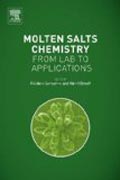
Molten salts and fused media provide the key properties and the theory of molten salts, as well as aspects of fused salts chemistry, helping you generate new ideas and applications for fused salts. Molten Salts Chemistry: From Lab to Applications examines how the electrical and thermal properties of molten salts, and generally low vapour pressure are well adapted to high temperature chemistry, enabling fast reaction rates. It also explains how their ability to dissolve many inorganic compounds such as oxides, nitrides, carbides and other salts make molten salts ideal as solvents in electrometallurgy, metal coating, treatment of by-products and energy conversion. This book also reviews newer applications of molten salts including materials for energy storage such as carbon nano-particles for efficient super capacitors, high capacity molten salt batteries and for heat transport and storage in solar plants. In addition, owing to their high thermal stability, they are considered as ideal candidates for the development of safer nuclear reactors and for the treatment of nuclear waste, especially to separate actinides from lanthanides by electrorefining. Explains the theory and properties of molten salts to help scientists understand these unique liquidsProvides an ideal introduction to this expanding fieldIllustrated text with key real-life applications of molten salts in synthesis, energy, nuclear, and metal extraction INDICE: Chapter 1 - Modelling of molten salts. Chapter 2 - Raman spectroscopy and pulsed neutron diffraction of molten salt mixtures containing rare earth trichlorides: trial approaches from fundamentals to pyrochemical reprocessing. Chapter 3 - In situ spectroscopy in molten fluoride salts. Chapter 4 - Thermodynamic calculations of molten salt reactor fuel systems. Chapter 5 - Ionic transport in molten salts. Chapter 6 - Salt bath thermal treating and nitriding. Chapter 7 - Catalysis in molten ionic media. Chapter 8 - The ability of molten carbonate for the gas cleaning of biomass gasification. Chapter 9 - Inert anode development for high temperature molten salts. Chapter 10 - Boron-doped diamond electrode in molten chloride systems. Chapter 11 - NF3 production from electrolysis in molten fluorides. Chapter 12 - Corrosion in molten salts. Chapter 13 - Plasma-induced discharge electrolysis for nanoparticles production. Chapter 14 - Electrolysis for recovery of actinides from molten LiCl-KCl. Chapter 15 - Electrochemical synthesis of novel niobium and tantalum compounds in molten salts. Chapter 16 - Preparation of carbonaceous materials in fused carbonates salts. Application to electrochemical storages devices. Chapter 17 - Molten carbonates from fuel cells to new energy devices. Chapter 18 - Synthesis and Li+ ion-exchange in molten salts of novel Hollandite-type Ky(Mn1-xCox)O2 zH2O nano-fiber for lithium battery electrodes. Chapter 19 - Hybrid molten carbonate/solid oxide direct carbon fuel cells. Chapter 20 - High temperature molten salts for solar power application. Chapter 21 - The sodium metal halide (ZEBRA) battery: an example of inorganic molten salt electrolyte battery. Chapter 22 - Hydrogen storage and transportation system through lithium hydride by using molten salt technology. Chapter 23 - Nuclear energy based on thorium molten salt. Chapter 24 - Molten salts for nuclear applications. Chapter 25 - Lanthanides extraction processes in molten fluoride media. Chapter 26 - Development of pyrochemical separation processes for recovery of actinides from spent nuclear fuel in molten LiCl-KCl.
- ISBN: 978-0-12-398538-5
- Editorial: Elsevier
- Encuadernacion: Cartoné
- Páginas: 592
- Fecha Publicación: 30/09/2013
- Nº Volúmenes: 1
- Idioma: Inglés
